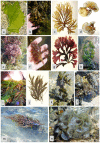Antioxidant and Antidiabetic Activity of Algae
- PMID: 36836817
- PMCID: PMC9964347
- DOI: 10.3390/life13020460
Antioxidant and Antidiabetic Activity of Algae
Abstract
Currently, algae arouse a growing interest in the pharmaceutical and cosmetic area due to the fact that they have a great diversity of bioactive compounds with the potential for pharmacological and nutraceutical applications. Due to lifestyle modifications brought on by rapid urbanization, diabetes mellitus, a metabolic illness, is the third largest cause of death globally. The hunt for an efficient natural-based antidiabetic therapy is crucial to battling diabetes and the associated consequences due to the unfavorable side effects of currently available antidiabetic medications. Finding the possible advantages of algae for the control of diabetes is crucial for the creation of natural drugs. Many of algae's metabolic processes produce bioactive secondary metabolites, which give algae their diverse chemical and biological features. Numerous studies have demonstrated the antioxidant and antidiabetic benefits of algae, mostly by blocking carbohydrate hydrolyzing enzyme activity, such as α-amylase and α-glucosidase. Additionally, bioactive components from algae can lessen diabetic symptoms in vivo. Therefore, the current review concentrates on the role of various secondary bioactive substances found naturally in algae and their potential as antioxidants and antidiabetic materials, as well as the urgent need to apply these substances in the pharmaceutical industry.
Keywords: algal treatments; antihyperglycemic; antioxidant; body weight; diabetes; lipid profile.
Conflict of interest statement
The authors declare no conflict of interest.
Figures





References
-
- International Diabetes Federation (IDF) IDF Diabetes Atlas. 2022. [(accessed on 31 January 2023)]. Available online: https://www.diabetesatlas.org/
-
- WHO W.H.O. Diabetes. [(accessed on 31 January 2023)];2022 Available online: https://www.who.int/news-room/fact-sheets/detail/diabetes.
-
- Akpaso M.I., Igiri A.O., Odey P.A. A comparative study on the effect of combined methanolic leaf extracts of Vernonia amygdalina and Gongronema latifolium and metformin on the pancreatic beta cells of streptozocin induced diabetic wistar rats. Asian J. Pharm. Nurs. Med. Sci. 2017;5:42–48. doi: 10.24203/ajpnms.v5i2.4591. - DOI
Publication types
LinkOut - more resources
Full Text Sources

